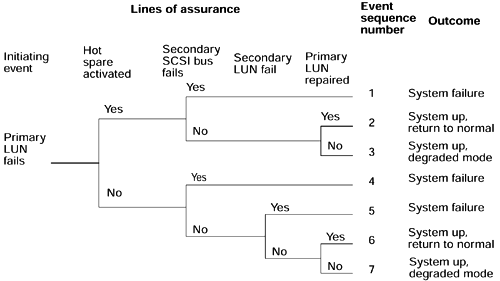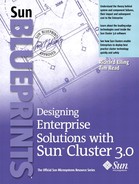Event Tree Analysis
Event tree analysis (ETA) is a low-level tool that is useful for describing failure sequences. You can use ETA to provide more detail on failure modes or effects for FMEA analysis. ETA occasionally reveals new failure modes within a system.
The ETA develops a model of outcome events based on an initiating event. Many events can be modeled, including automatic system responses and human responses. ETA effectively accounts for the timing, dependence, and domino effects among various contributors that are cumbersome to model in fault trees. If the probability of each event can be measured or predicted, you can also use ETA for risk assessment of service outages.
Because it is limited to one initiating event, ETA is not an exhaustive approach to analyzing failures. Also, you can easily overlook subtle dependencies. For example, common mode errors tend to be hidden. This can lead you to overly optimistic risk estimates.
Terms used in ETA include:
Initiating event—the first failure in the event tree
Line of assurance—a redundant system, safeguard, or process that can respond to an event
Branch point—graphical illustration of two or more potential outcomes when a line of assurance is challenged
Event scenario—a specific pathway through the event tree from the initiating event to an outcome
ETA Process
The ETA process is:
Define the system, component, or activity of interest.
You should limit the scope of the analysis, because many events may be possible in complex systems. Modeling all of them can be very time consuming.
Identify the initiating events of interest.
For highly available systems, an initiating event could be the failure of one of the redundant components.
Identify the lines of assurance and physical phenomena.
Identifying lines of assurance can help mitigate the consequences of the initiating event. These lines of assurance can include physical phenomena such as operator intervention or FRU replacement.
Identify the initiating event failure scenarios.
Identifying the possible failures and effects for each initiating event can provide a reference for an FMEA.
Analyze the event sequence outcomes.
For each event sequence, determine the possible outcomes and their probabilities.
Summarize the results.
The event trees can become quite complex. You can place a summary in a separate table for future reference.
ETA Example
“Boot Environment” describes an ETA example in a mirrored boot disk environment in which the hot spare and secondary mirror were attached to the same SCSI bus (FIGURE 6-10). This figure shows a failure mode in which a failure in the secondary disk data path follows the primary disk LUN failure. FIGURE D-6 is an example of an ETA that describes the failure modes shown in FIGURE 6-10.
Figure D-6. Mirrored Sun StorEdge D240 Media Tray—Event Tree Analysis

